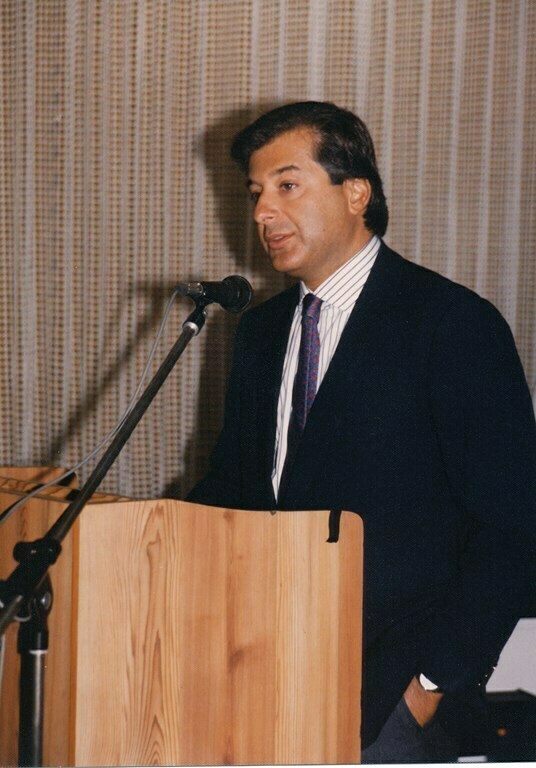 Describing his involvement as that of an observer in the 1970s, John Chandris said he became hands-on in the 1980s after his uncle became ill. At that point the Greek Chandris shipping family was running Chandris Fantasy Cruises with Harry Haralambopoulos as executive director.
Describing his involvement as that of an observer in the 1970s, John Chandris said he became hands-on in the 1980s after his uncle became ill. At that point the Greek Chandris shipping family was running Chandris Fantasy Cruises with Harry Haralambopoulos as executive director.
“The oil crisis in the ‘70s put the nail in the coffin for turbine ships,” he told Cruise Industry News. “Our ships were old, and we clearly saw the benefit of diesel powerplants. The industry was already moving into a second generation of cruise ships, and the scene was set for bigger, better and more efficient ships.”
He continued: “At that point, we were not yet in a position to order new ships, and we were still able to make good money with our turbine ships as long as we planned our itineraries carefully.
“But it became clear that if we were to continue, we needed a new platform. We had the choice of staying at the Fantasy level or doing something better.”
Celebrity Cruises
Thus, the Chandris Group created Celebrity Cruises. “We decided not to build to replace Fantasy, but instead to introduce something new.”
He said that innovation was a key driver for the new brand – from the structural elements of the ships to the onboard product. “The Horizon and the Zenith were the first ships to feature show lounges without columns for up to 1,000 people. We also introduced better food, private butler service and genuine onboard art collections.”
The biggest challenge was to find enough passengers to fill the beds every week. “It was us versus the 800-pound gorillas,” he noted.
Founded in 1988, nine years later Celebrity was sold to Royal Caribbean.
Challenges
Looking forward, although no longer involved, Chandris said the industry faces a number of challenges, including the sheer size of the ships from a safety point of view.
“We were the first company to double the number of life jackets we kept at the muster stations,” he said. “Demitrios Kaparis (senior vice president of corporate development and newbuildings) was a great protagonist of safety.
“I am concerned today after I saw people airlifted two at a time in a basket from the burning ferry in the Adriatic last December. Obviously, the bigger the ship, the bigger the challenge.
“Another issue is to maintain product quality with the larger volume of passengers (and crew), while also taking cost out of the product.”
Chandris said he was also concerned that the big publicly traded cruise companies have board members that have little or no understanding of the industry.
“Look at the share price for Royal Caribbean today,” Chandris said during a January interview, “it is finally where it should have been 10 years ago.
“Now, I hope they will be conservative with the number of ships they build and continue to focus on innovation and safety.”
Tomorrow
As for where tomorrow’s passengers will come from, he said: “China is clearly an incredible market, but will require a specific set of operational criteria. Just look at the number of quality cars being sold in China; it shows the market’s appreciation for quality.
“But America still leads the world and will continue to do so. Americans are hard working and take shorter holidays. For them, the seven-day product is ideal.”
Cruise may be a tougher sell in Europe, he said, because many Europeans can easily just drive and visit destinations within a few hours or even less. “It comes down to location and habits.”
Fundamentals
“Fundamentally, the key driver for the industry is product delivery. The objective must be to deliver the best possible product at a sensible price and produce a sensible margin,” he said.
“In addition you have to be innovative or you become stale. Richard Fain (chairman and CEO of Royal Caribbean) has been more creative than anybody else. With more brands it is harder, because you have to spread your focus so much. But unless you innovate, you become stale, and some brands have become stale.
“We did not just put our money to work, but also intelligence and ideas behind the scenes. For example, our ships had a trunk duct for piping running front to aft so all the piping could be easily inspected. We also had a track rail in the engine room for moving heavy components.”
Chandris added that the cruise industry has sourced a lot of ideas from the hotel industry and from each other. “I did quite a lot of cruising on competitors’ ships before we placed our newbuild orders. I saw what I liked and what I thought was missing: a touch of luxury, finesse and excellence. Our tagline for Celebrity was ‘exceeding expectations.’”
—
This article ran as part of a special Legends and Leaders section of the 100th edition of Cruise Industry News Quarterly Magazine, Spring 2015. A PDF download is available here.
Related articles:
Ted Arison: Creating the Fun Ships
Micky Arison: Exceeding Expectations
Nicola Costa: Developing Europe
Arne Wilhelmsen: Next: Sensible Growth
John Chandris: Innovation is Key
Art Rodney: Launching New Brands
Helge Naarstad: The Ultimate Experience
Stanley McDonald: Full Ships from Day One
Barney Ebsworth: It’s All About Marketing




